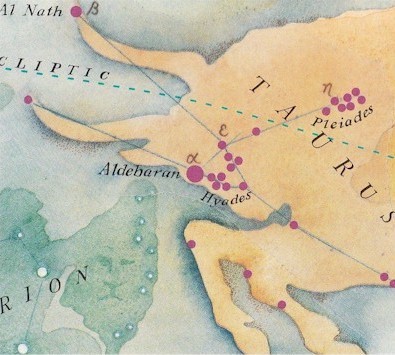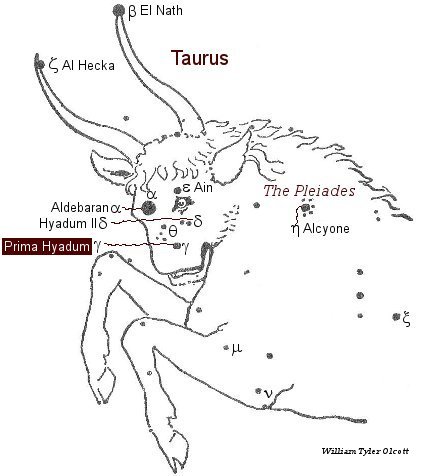The Hyades
Taurus is composed of two main groups of stars; the Pleiades and Hyades. The face of Taurus is marked by the V-shaped group of stars called the Hyades.
 The Hyades consist of Theta1 (θ1) Taurus, theta2 (θ2) Taurus, gamma(γ, Prima Hyadum) Taurus, delta (δ Hyadum11) Taurus, and epsilon (ε Ain) Taurus. Some include alpha (α Aldebaran) which is the largest star in that area and marking the Bull’s left eye, but another star, gamma, is called Prima Hyadum, meaning chief star in the Hyades, so technically Aldebaran is not part of the Hyades.
The Hyades consist of Theta1 (θ1) Taurus, theta2 (θ2) Taurus, gamma(γ, Prima Hyadum) Taurus, delta (δ Hyadum11) Taurus, and epsilon (ε Ain) Taurus. Some include alpha (α Aldebaran) which is the largest star in that area and marking the Bull’s left eye, but another star, gamma, is called Prima Hyadum, meaning chief star in the Hyades, so technically Aldebaran is not part of the Hyades.
The Hyades were the seven daughter of Atlas and Aethra, half sisters of the Pleiades, with whom they were entrusted by Jupiter with the care of the infant Bacchus/Dionysus. They were placed among the stars as a reward for their sisterly love, which was evinced by their sorrow at the death of their brother Hyas who was drowned in a well, or, in another version of the myth, he was killed by a wild beast in Libya. The Roman poet Ovid (43BC.-17AD) records that the sisters were grief-stricken and their tears fall on us as rain.
“For Hyas his mother wept, and for Hyas his sad sisters, and Atlas, soon to bow his neck to the burden of the pole, yet the love of the sisters exceeded that of both parents: it won for them a place in the sky, but Hyas gave them their name.” (Ovid, Fasti 5.170).
The History of the Hyades
from p.383 of Star Names, Richard Hinckley Allen, 1889.
[A scanned copy can be viewed on this webpage]
The Hyades marked by the sailor.
— Potter’s translation of Euripides’ …
As when the seaman sees the Hyades
Gather an army of Cimmerian clouds,
Auster and Aquilon with winged steeds.
— Christopher Marlowe’s History of Doctor Faustus.
The Hyades lie 10° southeast of the Pleiades, Whitening all the Bull’s broad forehead, forming one of the most beautiful objects in the sky, and have been famous for ages, especially with the classical authors.

Anciently supposed to be seven in number, we moderns count but six, and Hesiod named only five, — Kleea, Eudora, Koronis, Phaeo, and Phaesula; but Pherecydes gave a complete list of them, although one of his names has been lost, and the rest, preserved by Hyginus, vary from those given by Hesiod, and doubtless are somewhat corrupted in form. These were Aesula or Pedile, Ambrosia, Dione, Thyene or Thyone, Eudora, Koronis, and Polyxo or Phyto. Pherecydes probably took in beta and zeta, at the tips of the horns, omitting some of the fainter stars now included in the group; Thales, however, is said to have acknowledged but two, — alpha and epsilon in the eyes, — “one in the Northern Hemisphere, and the other in the South”; Hipparchos and Ptolemy named only alpha and gamma as Uadon; Euripides, in the Phaethon, counted three; and Achaeus, four. Ovid used Thyone for the whole, but none of the sisters’ names have been applied to the individual stars as in the case of the Pleiades.
They are among the few stellar objects mentioned by Homer, — and by him, Hesiod, Manilius, Pliny, and doubtless others, given separately from Taurus. Pliny called them Parilicium, from their lucida, Aldebaran.
The Greeks knew them as Uades, which became “Hyades” with the cultured Latins, supposed by some to be from uein, “to rain,” referring to the, wet period attending their morning and evening setting in the latter parts of May and November; and this is their universal character in the literature of all ages. Thus we have Hyades Graiis ab imbre vocat of Ovid’s Fasti; pluviasque Hyadas of the Aeneid and of Ovid again; and pluviae generally, which Manilius expressed in his
Sad Companions of the turning Year.
While far back of all these, in the She King:
The Moon wades through Hyads bright,
Foretelling heavier rain.
Pliny wrote of them as being “a violent and troublesome star causing stormes and tempests raging both on land and sea”; in later times Edmund Spenser called them the Moist Daughters; Tennyson, in his Ulysses, said:
Thro’ scudding drifts the rainy Hyades vext the dim sea;
{Page 388} and Owen Meredith has “the watery Hyades” in The Earl‘s Return. The queer old Guide into Tongues of John Minsheu, calling them the Seven Stars, — the only instance of this title that I have met for this group, — makes still more intimate their connection with the showers; for at its word Hyades the reader is referred to the word Raine, where we see:
Hyades, uades, dictae stellae quaedam in cornibus Tauri; quae ortu occasuq, sus pluvias largosque imbres concitant.
And in Doctor Johnson’s Dictionary the word is defined as “a watery constellation.” Thus they have always been considered most noteworthy by husbandmen, mariners, and all who were dependent upon the weather, even to the last two or three centuries.
Ovid called them Sidus Hyantis, after their earthly brother, Hyas, whose name, after all, would seem to be the most natural derivation of the title; and it was their grief at his death which gave additional point to Horace’s tristes Hyadas, and, in one version of their story, induced Jove to put them in the sky.
But their colloquial title among the Roman country-people was Suculae, the Little Pigs, as if from Sus, Sow, the Greek Us, Homer’s Sus, which indeed might as well be the derivation of Greek Uades; as uein. This name constantly occurs in astronomical literature from the time of Columella and Pliny to Kepler, Hevelius, and Flamsteed; Pliny accounting for it by the fact that the continual rains of the season of their setting made the roads so miry that these stars seemed to delight in dirt, like swine. And this idea, trivial though it seems, was sufficiently prevalent for Cicero, a century before Pliny, to think worthy of contradiction in his De Natura Deorum. Smyth said that the title might come from the resemblance of the group to a pig’s jaws; or because Aldebaran and its companion stars were like a sow with her litter. Peck suggests, in his Dictionary of Classical Literature and Antiquities, that Suculae was the oldest Roman name, given before the Greek appellation was known, and to be compared with our popular stellar titles such as the Dipper, Charles’ Wain (in Ursa Major), etc. Isidorus traced it to sucus, “moisture,” a pleasanter derivation, and possibly more correct, than that held in ancient Italy. This will account for Bayer’s Succidae.
Bassus and others knew the group as (Greek) u-psilon, the symbol with Pythagoras for human life; and the Roman V, as it resembles those letters, — alpha and epsilon being the extremes, gamma at the vertex. But Ulug Beg’s translator wrote:
“Quinque stellae quae sunt in facie, in forma lambdae Graecorum et forma rov Dal.”
In the Alfonsine Tables we find Lampadas, the accusative plural of Lampada, a Torch.
{Page 389} Occasional Arabic titles were Al Mijdah, a Triangular Spoon, and Al Kilas, the Little She Camels, referring to the smaller stars in distinction from Aldebaran, the Large Camel; Al Ferghani wrote the word Kala’is. These Little Camels appeared in one Arabic story as driven before the personified Aldebaran, in evidence of his riches, when he went again to woo Al Thurayya, the Pleiades, who previously had spurned him on account of his poverty. Another author made the word Al Kallas, the Boiling Sea, so continuing in Arabia the Greek and Roman ideas of its stormy and watery character. Generally, however, in that country, the Hyades were Al Dabaran, which was adopted in the 1515 Almagest, as well as in the Alfonsine Tables of 1521, where we read sunt stellae aldebaran, specially referring to the star gamma “of those in the face.” The Arabic title, therefore, was identical with that of the 2nd manzil (Arabic Moon Mansion), which these stars constituted, as they also did the 2nd nakshatra (Hindu Moon Mansion), Rohini, Aldebaran marking the junction with the adjacent Mrigacirsha.
The Hindus figured this asterism as a Temple, or Wagon; and there are many astrological allusions to it in the Siddhantas, the collective term for the various standard astronomical books of that people.
The Chinese utilized it for their 2nd sieu (Chinese Moon Mansion), Pi, or Peih, anciently Pal, a Hand-net, or a Rabbit-net, but included lambda and sigma; although some limited this station to epsilon, the farthest to the north. The She King thus described it:
Long and curved is the Rabbit Net of the sky;
but with that people generally it was the Star of the Hunter, and, with the astrologers, the Drought Car. This title, however, was inappropriate, for the Hyades seem to have been as closely identified with rain in China as in Greece or Rome, — indeed were worshiped as Yu Shi, the General, or Ruler, of Rain, from at least 1100 B.C. Still this character was not native, but must have been derived from western Asia, where the early rains coincided with the heliacal rising of these stars, which was not the case in China by nearly two months. The adjacent small stars, with xi, were Tien Lin, the Celestial Public Granary; and the whole group was known as the Announcer of Invasion on the Border.
The Hyades have been identified with the scriptural Mazzaroth, but there is little foundation for this; even less than for their identification, by Saint Jerome and by Riccioli, with the Kimah of the Book of Job, ix, 9.
Anglo-Saxon titles are Raedgastran, Raedgasnan, and Redgaesrum, whatever these may mean; and the Boar–Throng which that people saw in the sky may have been this group rather than Orion as generally is supposed.
It is thought that the Hyades have a united proper motion towards the {Page 390} west. They are rich in doubles and full of interest to the owners of even small glasses.
[Star Names: Their Lore and Meaning, Richard H. Allen, 1889.]